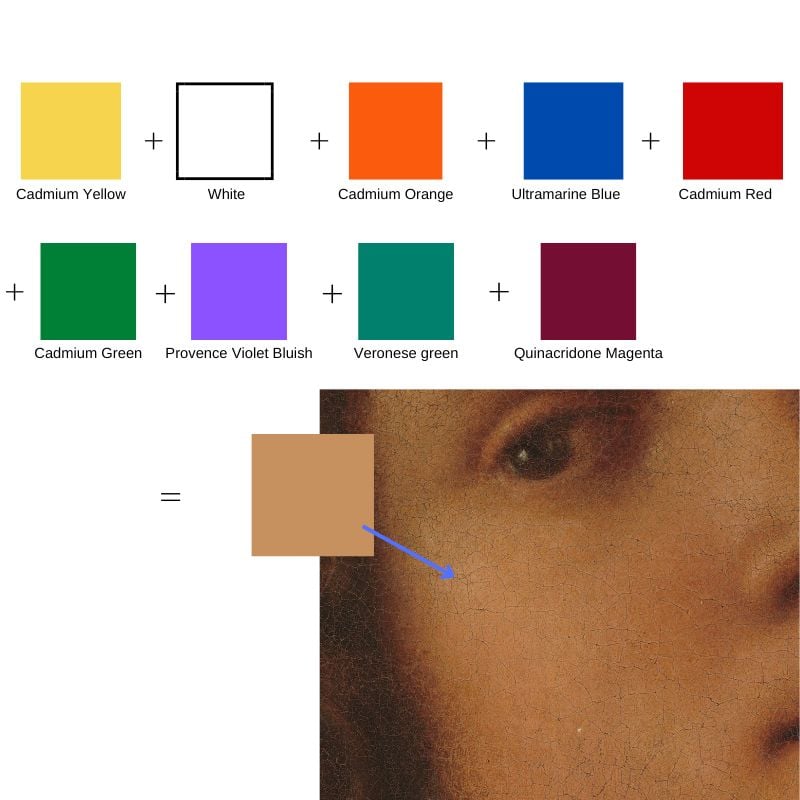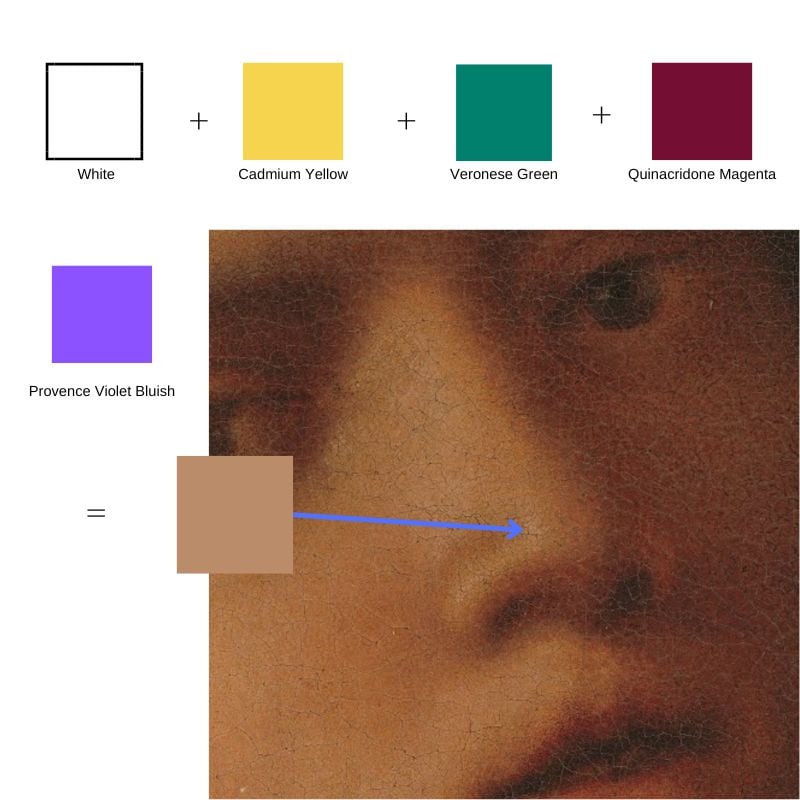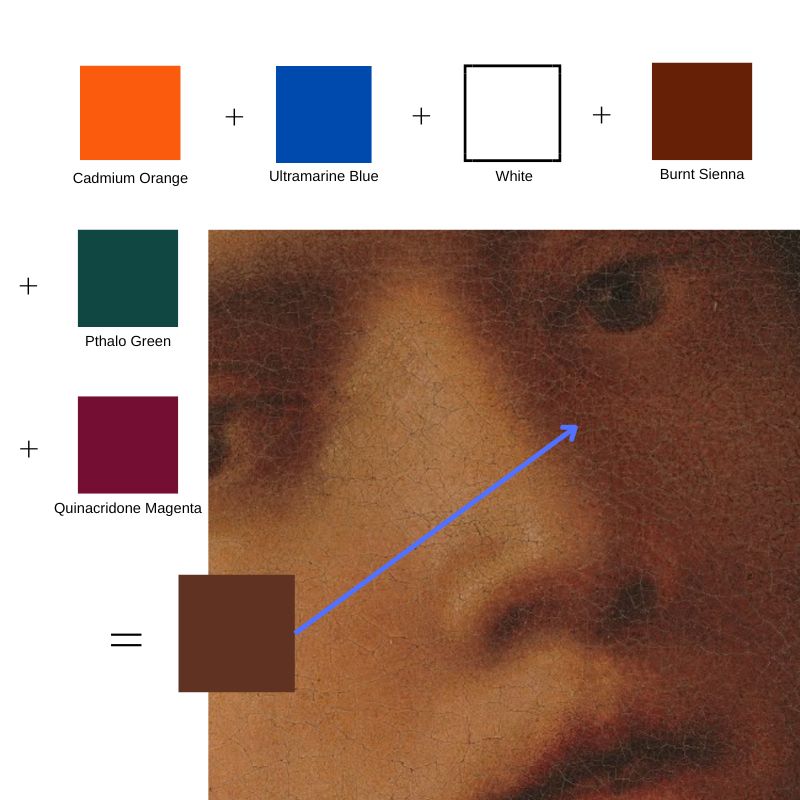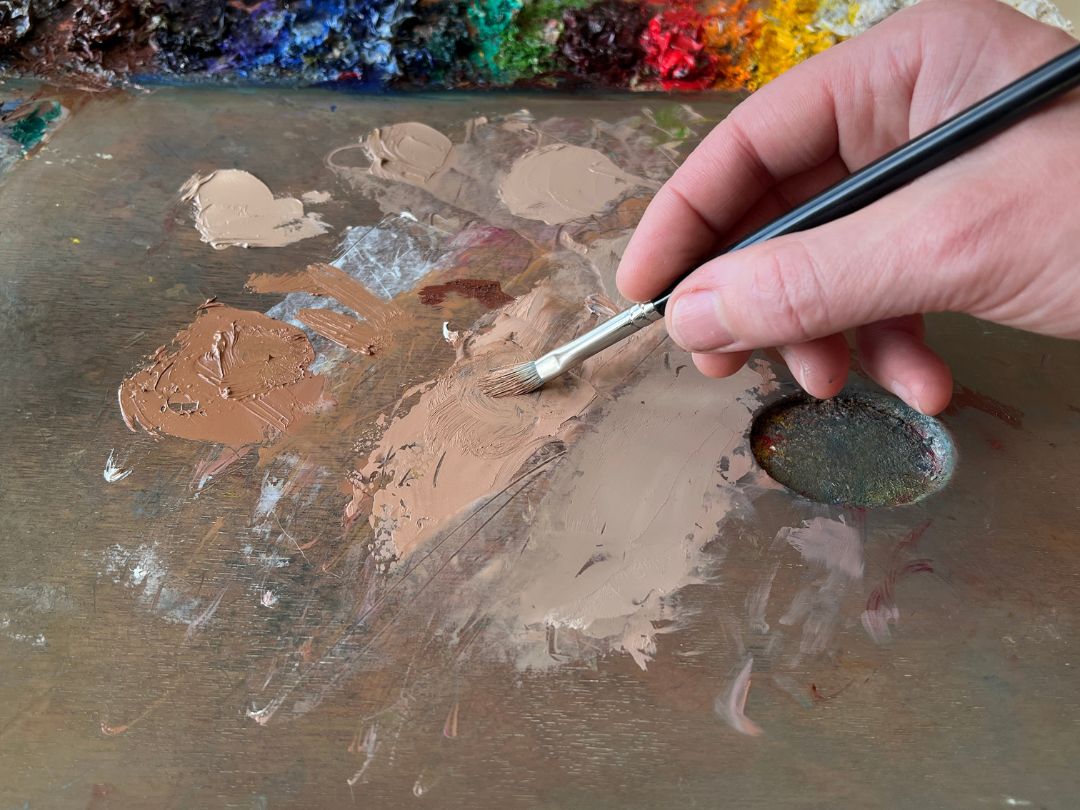Mixing skin tones can seem daunting at first. However, once you understand a few skin tone color mixing basics. You’ll have the ability to move move forward mixing colors for your (portrait and figure) paintings with greater ease!

In this article, you’ll find skin color chart diagrams and mixing instructions. So that you can see exactly what colors to mix together to create a variety of different skin tone colors for your painting. Let’s get started!
Getting started mixing skin tones

It is very important to understand and keep in mind that mixing skin tone colors requires mixing all sorts of colors together – yellows, blues, oranges, reds, greens etc. Colors that you don’t readily associate with flesh colors. Skin tones often have a subtle shade of blue, green, or purple among many other colors. Of course, it isn’t a full blown color straight from a paint tube – but just a subtle flavor of it in the color mixture.
Skin tone subject
To illustrate how to mix different light, mid-tone, dark (and more) flesh tone colors. We will be taking a close look at the painting below that is attributed to Giorgione. Who was a very influential artist that helped bring forth the high renaissance. He had immense technical skill – which is why we will look at his work!

For this lesson, our focus will be breaking down the skin colors that are in the portrait that is to the left. It looks like it has a range of earth tone colors, but there is much more to it than that!
How to mix mid-value skin tone colors
Here is a middle value skin tone color mixture that uses Cadmium Yellow, white, Cadmium Orange, Ultramarine Blue and Provence Violet Bluish.

The color spot that the arrow points to in the diagram has a yellowish undertone – which is why cadmium yellow (medium) is a major color in the mixture. The purple will help to mute the color and darken it, while the orange will make the color a little warmer in temperature. Ultramarine blue helps to mute the orange color as well as darken the mixture slightly.
It might initially surprise you as to how dark the mid-value color mixture is in this portion of the portrait painting. However, when you approach a painting − your light, medium and dark values will all be relative to each other. Which is why it’s important that you don’t predetermine in your mind, what a medium, light or dark skin color looks like when you go to mix it. Rather, allow the values that you observe in your subject guide you.
Using complementary colors

Complementary colors are incredibly important and useful for mixing skin tone colors. You will find yourself using them time and time again.
When initially starting a portrait or figure painting, it is helpful to mix up a large portion of a middle tone value color as the one above. Then you can use it to mix up variations later on in your painting.
Mixing WARM (mid-value) skin tones

It is extremely important to know how to breakdown the color temperatures of the skin tones you are trying to capture. Here we see a slightly darker color, which is also a little warmer in temperature. You can see that the mixture is rather similar to the one above. However the warmer skin tone color, has red and green added to it. The red will help to warm the color a little bit, while the green will mute it just enough.
Mixing skin tones requires great subtlety
You will often encounter such subtle color changes when mixing up skin tone colors for a portrait of figure painting. Which is why it is very practical to reuse the color that was mixed up for the previous color spot. So that you can then simply mix in the necessary colors to change it slightly.
How to mix light skin tone values
Below, you can see a lighter skin tone color value mixture on the left side of the portrait and how to create it.

When viewing the light skin color on its own, it doesn’t look significantly lighter in value than the previous two color mixtures. However, in the context of the painting, it makes a world of difference! That is why it is much more important how your colors relate to one another on your painting than on your palette.

Small amounts of colors to create subtle changes
The veronese green will help to give the color a slightly cooler color temperature (along with the blue and purple). You just need to add a very small amount – as mixing skin tone colors requires great subtlety!
Not much cadmium red or quinacridone magenta will be needed as well, but they are still important. On the other hand, a decent amount of white is needed.
Mixing highlight skin tone colors

Now we have a color spot that serves as the highlight on the nose. On its own, the color does not look very light in value. Though, because of its context and the colors that surround it, it looks quite bright.
Cool temperature highlight color
For the highlight color mixture, you will first mix together white and yellow. After that, mix in a very small amount of purple to mute it. You would then warm the color up a little bit, using quinacridone magenta. Since the color is ultimately cooler in temperature, in comparison to the colors around it. You would need a cool green (veronese green) to mute the quinacridone magenta just a little bit.
How to mix dark skin tones (and shadows)

Lastly, we have a very dark skin tone mixture for the shadow area on the right side. It is often under estimated how dark the shadow section of a portrait or figure painting can be.
Ultramarine blue and cadmium orange serve as a great base to create a dark muted orangey color. A little bit of burnt sienna will help to darken and warm the color further. Pthalo green and quinacridone magenta will additionally help to darken the color. However, it is important to mix in more quinacridone magenta than pthalo green to keep the color warm in temperature.
Ways to put mixing skin tones into practice
One of the best ways to move forward is to just start mixing up skin tone colors on your own. Take the information from this article and apply it to one of your own projects. Paint a portrait of a friend. Or even do a simple self portrait painting of yourself, by using a mirror to paint from!
Don’t get discouraged if things don’t go your way right away with the color mixing process. Color mixing truly requires time, practice and experimentation. It is also important to understand the basics of how color works. Once you have that – then you can really explore and mix up any color that you need!






10 thoughts on “Mixing Skin Tones: How to Mix Different Skin Tone Colors”
HI Elizabeth. I love all the articles you provide on painting. They are so informative and helpful. I have a question regarding mixing skin tones. Do you ever use yellow ochre instead of cadmium yellow? Thank you, Chrissy
Hi Chrissy, Am so glad to. hear that – thank you for your kind words! Yes, yellow ochre can be a very helpful color for mixing skin tones. I use it all the time! However if you need the skin tone to be a little bit more yellowy/saturated thats where yellow ochre won’t help so much. As yellow ochre is quite muted in comparison. However, there are often situations in which yellow ochre will be the precise color you need!
Hi Elisabeth. Thank you for this one; although I don’t do portrait work at the moment I am sure it will be very helpful for me in the future. I had to have a break from drawing/painting during a very cold spell here with a medical problem I have. I am back painting/ drawing again, and I enjoy reading your emails; I have learned at lot since joining; I look forward to more in the future.
Thank you, Kind regards.
Mike D
Hi Mike, Am glad to hear that you are back with drawing/ painting again and are enjoying the e-mails and have been learning a lot from them! Thank you for sharing that. I hope that everything gets resolved with the medical problem and that it doesn’t affect your painting time. Kind Regards, Elisabeth
Elisabeth, thank you for brilliantly explaining and illustrating your helpful exercises as well as for encouraging experimentation with both the core and more advanced concepts! I particularly benefit from your use of reference paintings from masters including Vermeer, Giorgione, and others. And also from how you simplify the order of mixing colors, with color squares presented in order! You really are remarkable and very much appreciated!
Hi Mike, Thank you for your kind words – am very glad that the exercises and explanations are helpful. You are very welcome! Thank you very much for sharing – I appreciate it.
I’m completely surprised at the number of colors used to get skin tones. Thank you for this valuable info.can’t wait to try mixing.
Hi Kay, Yes! There are quite a few colors that can go into mixing skin tones. Glad this information is helpful!
Very helpful
Glad this is helpful for you Carol